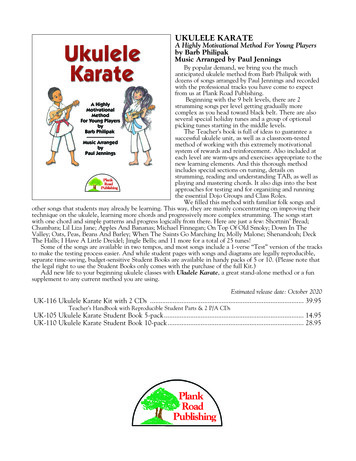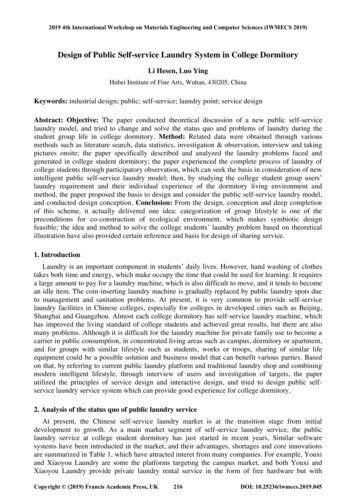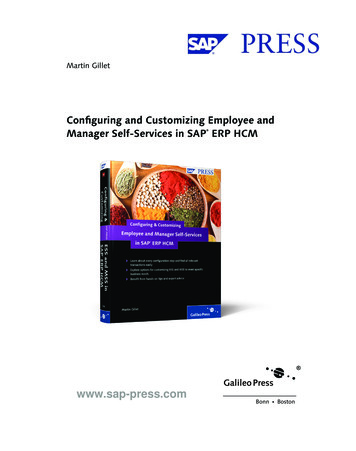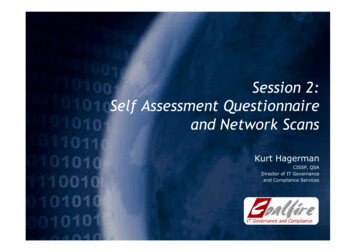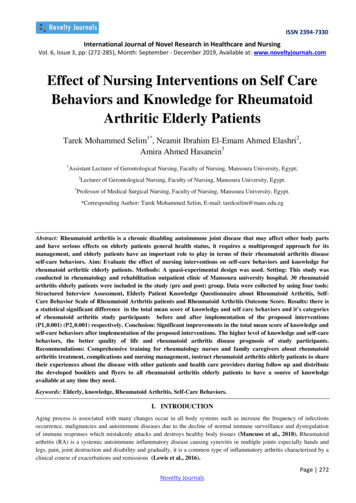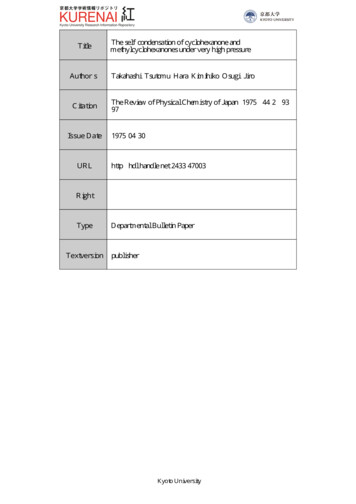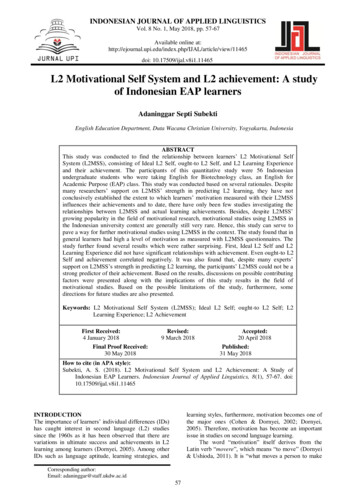
Transcription
INDONESIAN JOURNAL OF APPLIED LINGUISTICSVol. 8 No. 1, May 2018, pp. 57-67Available online view/11465doi: 10.17509/ijal.v8i1.11465L2 Motivational Self System and L2 achievement: A studyof Indonesian EAP learnersAdaninggar Septi SubektiEnglish Education Department, Duta Wacana Christian University, Yogyakarta, IndonesiaABSTRACTThis study was conducted to find the relationship between learners’ L2 Motivational SelfSystem (L2MSS), consisting of Ideal L2 Self, ought-to L2 Self, and L2 Learning Experienceand their achievement. The participants of this quantitative study were 56 Indonesianundergraduate students who were taking English for Biotechnology class, an English forAcademic Purpose (EAP) class. This study was conducted based on several rationales. Despitemany researchers’ support on L2MSS’ strength in predicting L2 learning, they have notconclusively established the extent to which learners’ motivation measured with their L2MSSinfluences their achievements and to date, there have only been few studies investigating therelationships between L2MSS and actual learning achievements. Besides, despite L2MSS’growing popularity in the field of motivational research, motivational studies using L2MSS inthe Indonesian university context are generally still very rare. Hence, this study can serve topave a way for further motivational studies using L2MSS in the context. The study found that ingeneral learners had high a level of motivation as measured with L2MSS questionnaires. Thestudy further found several results which were rather surprising. First, Ideal L2 Self and L2Learning Experience did not have significant relationships with achievement. Even ought-to L2Self and achievement correlated negatively. It was also found that, despite many experts’support on L2MSS’s strength in predicting L2 learning, the participants’ L2MSS could not be astrong predictor of their achievement. Based on the results, discussions on possible contributingfactors were presented along with the implications of this study results in the field ofmotivational studies. Based on the possible limitations of the study, furthermore, somedirections for future studies are also presented.Keywords: L2 Motivational Self System (L2MSS); Ideal L2 Self; ought-to L2 Self; L2Learning Experience; L2 AchievementFirst Received:4 January 2018Final Proof Received:30 May 2018Revised:9 March 2018Accepted:20 April 2018Published:31 May 2018How to cite (in APA style):Subekti, A. S. (2018). L2 Motivational Self System and L2 Achievement: A Study ofIndonesian EAP Learners. Indonesian Journal of Applied Linguistics, 8(1), 57-67. doi:10.17509/ijal.v8i1.11465learning styles, furthermore, motivation becomes one ofthe major ones (Cohen & Dornyei, 2002; Dornyei,2005). Therefore, motivation has become an importantissue in studies on second language learning.The word “motivation” itself derives from theLatin verb “movere”, which means “to move” (Dornyei& Ushioda, 2011). It is “what moves a person to makeINTRODUCTIONThe importance of learners’ individual differences (IDs)has caught interest in second language (L2) studiessince the 1960s as it has been observed that there arevariations in ultimate success and achievements in L2learning among learners (Dornyei, 2005). Among otherIDs such as language aptitude, learning strategies, andCorresponding author:Email: adaninggar@staff.ukdw.ac.id57
Indonesian Journal of Applied Linguistics, 8(1), May 2018concerned. First of all, the notion “integrative” inGardner’s model was originated from the Canadiancontext in which French, the L2 in his study’s context,was widely spoken by Canadian participants as it wasthe second official language after English. Thus, thisnotion might lose its relevance when applied to contextsin which the L2 is used as “foreign language” and thuslearners have relatively minimal exposure to thelanguage (Dornyei & Ushioda, 2011). Furthermore,Norton (2000) argued that Gardner's and associates'distinguishing learners into "integratively oriented" and"instrumentally oriented" is problematic in the firstplace. He argued that it is not possible to categoriselearners' orientation in such clear-cut criteria.Interestingly, in at least two of his works, Gardner diduse these two notions as a pure dichotomy (see Gardner& MacIntyre, 1991; Gardner, Masgoret, Tenant, &Mihic, 2004). Besides, there has been confusion inmany motivational studies using Gardner’s frameworkon the concept of orientation and motivation. WhilstGardner clearly emphasised that orientation refers to thereason of studying an L2 and motivation is the drivingforce (Gardner & MacIntyre, 1991; Gardner &Tremblay, 1994), many studies using Gardner’sconcepts of integrative and instrumental notions havefailed to see the difference between them. Such studiesas those of Choubsaz and Choubsaz (2014), Samad,Etemadzadeh, and Far (2012), and Yu and Downing(2012), for examples, did treat orientation andmotivation as the same entity, despite the fundamentaldifference between the two notions. Furthermore, therise of Global English notion also contributes to thedecreasing popularity of Gardner’s concepts (Dornyei &Ushioda, 2011; Kachru & Nelson, 2006). Jenkins (2006)stated that in Global English perspective, rather thanseeing native users of English as the benchmark of“right” or “wrong” for L2 users of English, all varietiesof English, native or non-native, are equally accepted asit emphasises on intelligibility and allows learners to useEnglish with their own characteristics such aspronunciations, accents, and diction without comparingthem with those of English native users. Hence, thegrowing prominence of Global English also carries theconsequence that the notion “integrative orientation”loses its reference because more and more L2 learnersno longer look up to English speaking community inlearning English (Dornyei & Ushioda, 2011; Islam,Lamb, & Chambers, 2013; Lamb, 2004; Ortega, 2009;Ushioda, 2006). In addition, rather than interested in L1speakers of English, many English learners nowadaysdevelop a bicultural identity in which they identifythemselves as a part of both their local culture and theglobal community (Lamb, 2004; Yashima, 2002, 2009).certain choices, to engage in action, to expend effort andpersist in action” (Dornyei & Ushioda, 2011, p. 3).Hence, drawing the etymological definition into L2learning context, Dornyei (2005) and Ortega (2009)argued that motivation nurtures more successfullanguage learning. Dornyei (2005) further stated thatmotivation gives the primary impetus to begin L2learning and it then becomes “the driving force tosustain the long and often tedious learning process”(Dornyei, 2005, p. 65). In line with that, Sternberg(2002), an expert in language aptitude, stated thatmotivation plays a vital role in sustaining learners tokeep learning, at times, despite their possibledeficiencies in aptitude. Without sufficient motivation,Dornyei (2005) emphasised, even learners of abilitiescannot accomplish long-term goals and neither goodteaching nor curricula enough on their own can ensuretheir success. Due to the acknowledgement of theimportance of motivation in language learning,furthermore, many studies have been investigating thisfield.Early studies on motivationStudies on motivation were initiated by the seminalworks of Gardner and his students in Canadian context(see Gardner & Lambert, 1959, 1972) which startedwhat motivational researchers call as the socialpsychological period (1959-1990). During this period, itwas argued that language learning was affected byvarious sociocultural factors such as language attitudes,cultural familiarity, and stereotypes (Gardner &Lambert, 1972). This view gave rise to the prominentnotions of integrative and instrumental orientations asthe antecedents of motivation. Even though Gardner didmention other orientations in his subsequent works (seeGardner, 1985; Tremblay & Gardner, 1995), he seemedto emphasise the two aforementioned orientations overthe others in a model called Socio-Educational Modelconsisting of three elements, which are, effort, desire,and positive attitude (Gardner, 1985; Gardner &MacIntyre, 1993). Integrative orientation is defined aslearners' interest in L2 learning triggered with theirinterest in the L2 culture and community (Gardner &Lambert, 1972). Having integrative orientation, learnersare believed to be encouraged to learn more about theL2 culture and community. Different from theintegrative orientation which focuses on learners' desireto learn the target language's community and culture,instrumental orientation is more related to pragmaticbenefits. For example, someone studies English to getbetter job opportunities in the future, to get promoted atwork, or to get a higher salary. Gardner (1985) statedthat to sustain L2 learning, integrative orientation has amore vital role than the instrumental one.Since the 1990s, however, motivational studieshave inclined to concepts of motivation put forward byDornyei and associates, a phenomenon attributed to thepossible weaknesses on the explanatory power ofGardner’s concept and the growing prominence ofGlobal English, at least as far as English learning isDornyei’s L2 Motivational Self System (L2MSS)Nowadays, L2 motivational studies have shifted to thesocio-dynamic period, fuelled by the work of Dornyeiknown as L2 Motivational Self System (L2MSS)framework (see Dornyei, 2005, 2009). Dornyei (2009)reconceptualised L2 motivation in the way that can addCopyright 2018, IJAL, EISSN 2502-674758
Indonesian Journal of Applied Linguistics, 8(1), May 2018our understanding from what Gardner and associateshave stated previously but make them relevant in today'sglobalised world with the growing prominence ofGlobal English. The substantial difference betweenGardner’s framework and that of Dornyei is that whilstimportant identifications in Gardner’s motivationalframework are with others, the L1 community andculture, in Dornyei’s framework, they are with thefuture version of the self. This model is inspired byHiggins' (1987) Self-Discrepancy Theory, in which iflearners see discrepancy between their current, actualstate as language learners and their desired, ideal selves,they will be motivated to reduce the discrepancy byeither learning a new language or improving theirproficiency of a language they have been learning.Markus' and Nurius' (1986) Theory of Possible Selves,which tends to be overlooked in Gardner's SocioEducational Model, is also highlighted in Dornyei’sL2MSS in which individuals can “see” the self in afuture state. That is their ideas of what they mightbecome, what they want to become, and what they areafraid of becoming (Dornyei & Ushioda, 2011).L2MSS,furthermore,consistsofthreecomponents, namely Ideal L2 Self, ought-to L2 Self,and L2 Learning Experience (see Dornyei, 2005, 2009).The first component, Ideal L2 Self, is our personalvision of what we desire to become as language users.Lamb (2012) stated that this component serves as amotivational power inspiring actions towards a desiredfuture and as the facilitator of self-regulation along theway. Dornyei and Ushioda (2011) asserted thatGardner’s notions of integrative and instrumentalorientations are incorporated in this component. As thiscomponent focuses on promotion or improvements,such as hope and accomplishment, learners who learnL2 in the hope that they can be a part of L2 community(integrative orientation) and those who learn L2 in thehope that they can get pragmatic benefits such as abetter salary, job opportunities, and job promotions(promotion-focused instrumental orientation) can besaid to have been guided by their Ideal L2 Self (Dornyei& Ushioda, 2011). The second component of L2MSS,furthermore, is ought-to-L2-Self, which refers to “theattributes that one believes one ought to possess”(Dornyei, 2005, p. 105). It is related to one's perceivedresponsibilities to avoid negative outcomes. Thus, thiscomponent is more extrinsic and less internalised thanthe previously mentioned component. Preventionfocused instrumental orientation in Gardner’s view isincorporated in this component (Dornyei & Ushioda,2011). An example of this component in languagelearners is learners who study hard with a pragmaticpurpose of avoiding getting bad scores in an exam orfailing their class. The last component, L2 LearningExperience, furthermore, refers to situation-specificmotives in relation to immediate learning experiencesand environments (Dornyei, 2005). This last componentacknowledges the possible effects of teachers,curriculum, classroom processes, classmates, and otherfactors around learners that can affect their motivationto learn L2 (Lamb, 2012).Supporting Dornyei's (2005, 2009) model ofL2MSS, Ushioda (2011) stated that compared toGardner’s model, Dornyei’s model has morecapabilities to approximate what individuals areexperiencing when they are engaging in goal-orientedbehaviours such as language learning. It is attributed tothe L2MSS’s ability to capture the complexity ofindividuals’ motivation rather than to categorize it in asuperficially clear-cut boundary (Ushioda, 2011). Dueto the stronger explanatory power of Dornyei’s L2MSSin understanding learners’ motivation, many recentstudies investigate learners’ motivation using L2MSS asthe theoretical framework in various learning contexts(E.g.: Henry, 2013; Islam et al., 2013; Khany & Amiri,2016; Lamb, 2012; MacWhinnie & Mitchell, 2017;Moskovsky, Racheva, Assulaimani, & Harkins, 2016;Papi, 2010; Papi & Temouri, 2013; Rajab, Far, &Etemadzadeh, 2012; Taguchi, Magid, & Papi, 2009;Ueki & Takeuchi, 2012; Yaghoubinejad, Zarrinabadi, &Ketabi, 2016; You & Dornyei, 2014; You, Dornyei, &Csizer, 2015).Studies on L2MSSOne of the most prominent studies on L2MSS is that ofTaguchi et al. (2009) which investigated L2MSS oflearners in three different contexts, Japan, China, andIran, in a comparative study involving 5,000participants in total. This s
Learning Experience did not have significant relationships with achievement. Even ought-to L2 Self and achievement correlated negatively. It was also found that, despite many experts’ support on L2MSS’s strength in predicting L2 learning, the participants’ L2MSS could not be a strong predictor of their achievement. Based on the results, discussions on possible contributing

